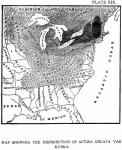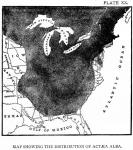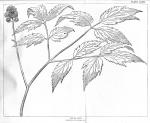 Parts used - Common names - Botanical description - Forms of Actaea - Geographical distribution - Botanical history - Description of the drug - Constituents - Medical history of Actaea alba - Pharmaceutical references to Actaea
Parts used - Common names - Botanical description - Forms of Actaea - Geographical distribution - Botanical history - Description of the drug - Constituents - Medical history of Actaea alba - Pharmaceutical references to Actaea
PARTS USED.—The rhizomes and rootlets of Actaea alba Bigelow, and Actaea spicata Linn., var. rubra Aiton. [In most medical works the two plants are considered as distinct drugs, but as the rhizomes are indiscriminately collected from both species, and afford no distinction, we have placed them under the same head.]
Natural Order Ranunculaceae, Tribe Helleboreae.
COMMON NAMES.—The species of Actaea are generally known in this country by a name derived from the Indians, viz. Cohosh, [There are four native plants called Cohosh: Black Cohosh, Cimicifuga racemosa; White Cohosh, Actaea alba; Red Cohosh, Actaea spicate var. rubra; Blue Cohosh, Caulophyllum thalictroides.] and are called White Cohosh or Red Cohosh, according to the color of the berries.
In addition to this name the plants have acquired the name Baneberry, from their English relative, and are called White and Red Baneberry. [The English plant, Actaea spicata, has acquired a reputation as a poisonous plant that it seems to us must be in most part unmerited. By old writers the plant was said to grow in dark recesses and to emit a fetid smell, which attracted toads, hence it is called toad plant. The berries were supposed to be poisonous, and the entire plant to poison cattle. Our native plants, which could hardly be distinguished from the foreign, seem to be entirely innocent of poisonous properties, and certainly do not emit any disagreeable odor.]
They are called Herb Christopher, Saint Christopher, or simply Christopher, names that have been applied from the earliest time to the English plant. [In ancient Catholic calendars nearly every day was dedicated to some saint, and a particular flower was connected with each, and usually acquired the name of the saint; thus we have Saint John's-wort, Saint Peter's-wort, etc. Several plants are mentioned in books as Saint Christopher, but Actaea spicata is most generally known under that name. We know of no special reasons why the plant should have been dedicated to this saint.]
The names Necklace Weed and White Beads have been given to Actaea alba in some works, from the resemblance the white berries of this plant bear to a bunch of beads. These names were applied by Eaton in all editions of his Manual, and hence were formerly generally known, but are now seldom used.
We have also seen the name Noah's Ark, and Coral-and-Pearl, given the plant in early medical works.
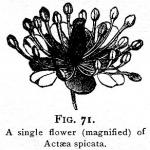
 BOTANICAL DESCRIPTION.—The genus Actaea, proper, consists of but a few species, all closely resembling each other, and is of wide distribution. The typical Actaea spicata is found in Europe, extending over a wide territory, but does not assume any marked varieties. We present a drawing of the flower and berry of this species.
BOTANICAL DESCRIPTION.—The genus Actaea, proper, consists of but a few species, all closely resembling each other, and is of wide distribution. The typical Actaea spicata is found in Europe, extending over a wide territory, but does not assume any marked varieties. We present a drawing of the flower and berry of this species.
In America there are three constant forms, and a number that are intermediate. They bear a very close resemblance to each other in habit, leaves and flowers, and only differ markedly in the fruit. Two of these plants are considered as varieties of the European plant; they are the Actaea spicata var. rubra, east of the Mississippi, and Actaea spicata var. arguta, of the Western States. Actaea alba is now classed as a distinct species.
As the Actaea alba and the Actaea spicata var. rubra (which are the only forms found over the States east of the Mississippi) bear such a close resemblance that they can hardly be distinguished except when in fruit, we will give a general description that will apply to both.
 The rhizome is knotted, horizontal and furnished with numerous fibrous roots. It is not very large, weighing an ounce or two when fresh, and grows within an inch or two of the surface. In the spring it sends up generally a single stem, sometimes two, and often a radical leaf.
The rhizome is knotted, horizontal and furnished with numerous fibrous roots. It is not very large, weighing an ounce or two when fresh, and grows within an inch or two of the surface. In the spring it sends up generally a single stem, sometimes two, and often a radical leaf.
The stem is erect, about two feet high, and at the base about the size of a lead pencil. It bears usually two large tri-ternate leaves, on clasping leaf stalks, and above each of these leaves, the thickness of the stem is reduced about one half. The leaflets are oval, acute, veiny, sharply and irregularly cut, toothed on the margins and more or less one or two lobed.

 The flowers appear in April or May, the white berried plant flowering a week later than the other. They are borne in a short, dense raceme, terminating in a stalk about four inches long. All parts of the flower are white. The sepals which enclose the flower in the bud fall away when it expands. The numerous white stamens are the most showy part of the flower.
The flowers appear in April or May, the white berried plant flowering a week later than the other. They are borne in a short, dense raceme, terminating in a stalk about four inches long. All parts of the flower are white. The sepals which enclose the flower in the bud fall away when it expands. The numerous white stamens are the most showy part of the flower.
After blooming, the flower stalk elongates, and when in fruit attains a length of about six inches. The two plants are distinguished by their fruit, hence we will separately describe the fruit of each. The chief characteristic between the two species is the size of the pedicel that bears the berry; in the Actaea alba it is thick and as large as the main stem that bears the bunch; in. the Actaea spicata var. rubra it is slender and much smaller than the main stem.
 The Fruit of Actaea Spicata var. Rubra.—This is a cluster of twenty to twenty-four berries. It matures in early July, and when ripe the color is bright, cherry red, the skin smooth and glossy. The bright color will attract the attention of the most casual observer when the berries are ripe. They are borne on slender stalks, about an inch long, which when the fruit is ripe are nearly horizontal.
The Fruit of Actaea Spicata var. Rubra.—This is a cluster of twenty to twenty-four berries. It matures in early July, and when ripe the color is bright, cherry red, the skin smooth and glossy. The bright color will attract the attention of the most casual observer when the berries are ripe. They are borne on slender stalks, about an inch long, which when the fruit is ripe are nearly horizontal.
 The berries are about the size of large peas and are tipped with small, blunt stigmas, and have sutures running from the base to the apex. They are flattened on the sutured side and attached to the pedicel obliquely at the base. The relative position of the sutures to the main peduncle of the bunch varies with almost every berry, but they usually face the ground. Beneath the skin of the berry is a pure white, pithy flesh, bitter to the taste, and inclosing about twelve angular seeds. These are arranged in two rows and are closely packed together. The berries seem to be specially liable to the attack of small, green worms, which were found in a large proportion of the berries examined by us.
The berries are about the size of large peas and are tipped with small, blunt stigmas, and have sutures running from the base to the apex. They are flattened on the sutured side and attached to the pedicel obliquely at the base. The relative position of the sutures to the main peduncle of the bunch varies with almost every berry, but they usually face the ground. Beneath the skin of the berry is a pure white, pithy flesh, bitter to the taste, and inclosing about twelve angular seeds. These are arranged in two rows and are closely packed together. The berries seem to be specially liable to the attack of small, green worms, which were found in a large proportion of the berries examined by us.
 The Fruit of Actaea Alba.—Actaea alba ripens its fruit in July and August, a few weeks after the red fruited species. It is a bunch of from ten to twenty berries, about the size of a cherry stone. The color of the berries when fully ripe is ivory white, but often they are tinged with red at the apex. They all are tipped with the blunt, black, persistent stigma.
The Fruit of Actaea Alba.—Actaea alba ripens its fruit in July and August, a few weeks after the red fruited species. It is a bunch of from ten to twenty berries, about the size of a cherry stone. The color of the berries when fully ripe is ivory white, but often they are tinged with red at the apex. They all are tipped with the blunt, black, persistent stigma.
The berries are borne on thick pedicels, about half an inch long, and as thick as the main stalk of the bunch. The pedicels turn red when the fruit is fully ripe; they are horizontal and generally slightly curved (upward), and are thickened or knobbed at the base.
The berries contain usually six smooth, wedge shape seeds, which are arranged in two vertical rows, and completely fill the berry.
In comparison with the fruit of Actaea spicata var. rubra, the fruit of Actaea alba differs as follows: It is borne on thickened pedicels; it is smaller; the tip is larger; the integument is much thicker; there is no pulp; the seeds are fewer (six) and larger, and their sides more slanting, and their surface smooth (not roughened).
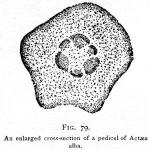
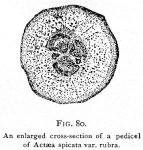 FORMS OF ACTAEA.—There are good botanists who contend that all the American Actaeas are varieties of the same species, and that the "alba" is not sufficiently distinct to be entitled to specific rank. As has been mentioned before, the only prominent distinction is in the fruit; its color, and the thickness of the pedicels. It has been stated that the woody bundles in the pedicel form an unvarying distinction; that they are three in the red-fruited plant and five in the plant with white fruit. At our request, Mrs. Stowell made an examination of a large number of pedicels of both plants, but failed to find any characteristic difference between them. She reports that the "alba" pedicels are much harder, firmer and darker than the 11 rubra," and that there is a difference in the size of the starch grains, those of the alba being much larger. The arrangement of the woody bundles is not alike in hardly any two pedicels of the "alba" nor in any two of the "rubra." The accompanying accurate drawings of a cross-section of a pedicel of each species can not be taken to represent the general appearance of either, because it varies with every specimen examined.
FORMS OF ACTAEA.—There are good botanists who contend that all the American Actaeas are varieties of the same species, and that the "alba" is not sufficiently distinct to be entitled to specific rank. As has been mentioned before, the only prominent distinction is in the fruit; its color, and the thickness of the pedicels. It has been stated that the woody bundles in the pedicel form an unvarying distinction; that they are three in the red-fruited plant and five in the plant with white fruit. At our request, Mrs. Stowell made an examination of a large number of pedicels of both plants, but failed to find any characteristic difference between them. She reports that the "alba" pedicels are much harder, firmer and darker than the 11 rubra," and that there is a difference in the size of the starch grains, those of the alba being much larger. The arrangement of the woody bundles is not alike in hardly any two pedicels of the "alba" nor in any two of the "rubra." The accompanying accurate drawings of a cross-section of a pedicel of each species can not be taken to represent the general appearance of either, because it varies with every specimen examined.
For more than thirty years it has been noticed by collectors that occasionally plants of Actaea are found with the distinctive character of the fruit directly contrary to the usual form, viz.: white berries with slender pedicels, or red berries with thick pedicels. Several observing botanists have reported these forms to us in the last year. Whether these are hybrids between the two species, or mere sports, we are not prepared to say, but our opinion is that they are the latter. [In this connection it is of interest that in England there have recently been discovered (and an account published in the Pharm. Journ. and Trans.) plants of Actaea spicata with white and also plants with red berries. Nothing but black berries had heretofore been known for the English species.]
Mr. Henry Gillman, who has given the subject of varieties much study, claims that the form with white berries and slender pedicels is quite constant and certainly a good variety, if not a species, for which he would suggest the name neglecta. We give his observations in full, as a note. ["Regarding the two forms of Actaea with white berries, that with the slender pedicels is, at least, a strongly marked variety, if not a distinct species. I have made careful examinations and comparisons, sometimes finding both forms in the same locality. I would add that in the variety, the pedicels are green and slender, leaves four-ternately compound, racemes ovate, peduncle longer, berry (white) larger, seeds fewer (about four), and much rougher, and very slightly groved. In the usual form, with thickened pedicels and white berries, the pedicels are red, the leaves three-ternately compound, racemes oblong, peduncles much shorter, berries smaller, seeds more numerous (five to seven), and nearly smooth, with deep groves. The differences appear to me to be specific, and I would suggest for the plant with slender pedicels the name Actaea neglecta."—Henry Gillman.]
Mr. J. S. Merriam, in the "Bulletin of the Torrey Botanical Club" (1872), claims that the two plants "alba" and "rubra" are distinctly characterized and easily recognized by the structure of the pedicel, whatever may be the color of the berries. The "rubra" has "long, green pedicels, hollow, and easily crushed between the thumb and finger. The "alba" has thick, solid pedicels, occasionally having a fine, thread-like hollow at the center, but are never easily crushed." [Mr. Merriam says; "The small, red berries on thick, short, red pedicels were as clearly of the 'alba' as the white ones. They have every characteristic but color, and that of a very different shape from the 'rubra.' This circumstance has made me doubt the observations on which is made the statement, 'white berries sometimes occur on slender pedicels, and vice versa;' for, in my case, though vice versa they were not 'rubra' in any sense."]
GEOGRAPHICAL DISTRIBUTION.—In almost all portions of our country one or two species of Actaea can be found. The Actaea alba and Actaea spicata var. rubra grow in most States east of the Mississippi, and the Actaea spicata var. arguta in the Western States. Neither of the species can anywhere be called an abundant plant, although in many places they are common in rocky woodlands and hillsides.
The Actaea spicata var. rubra is a northern species. Its home is the mountains of New Hampshire and Vermont and northern New York, where it is more common than Actaea alba. It extends south as far as the mountains of North Carolina and the States of Tennessee and Arkansas, but is only occasionally found. Over all the territory farther south than the forty-second parallel it is either entirely absent or rare.
Actaea alba is of more general distribution; while it is the common species in the Ohio Valley, it is equally at home on the mountains of Vermont and New Hampshire. A comparison of the two maps herewith presented will exhibit the relative distribution at a glance.
BOTANICAL HISTORY.—The genus Actaea was known to the earliest botanists from a species native of Europe, the Actaea spicata. In the crudest state of botanical classification the plant was included with the Aconites, perhaps from its reputed poisonous properties.
Tournefort called the genus Christophoriana, from the popular name of the plant; [See note, on page 232.] Linnaeus, in establishing the genus, called it Actaea. [The Greek Aκτεα and the Latin Actaea are names for the elder. Linnaeus transferred the name to this genus. it is supposed, from the resemblance of the leaves to the elder.]
The American plants have been designated by a variety of names, according to the specific rank accorded to them by the different writers. Some have considered them distinct species, others varieties of one American species, and others varieties of the European species. At the present time botanical authorities agree that the red-berried plant is a variety of the European species, and the white-berried plant a distinct species.
That there are two kinds of American "baneberry," distinguished by the color of the fruit, was noticed by the earliest observers. Morrison records the fact as early as 1680. Linnaeus considered the white-berried plant a variety of the European species, and called it (1753) Actaea spicata var. alba. The red-berried plant he did not designate, although he was aware of its existence from Morrison's reference, which he cites. Aiton referred both plants as varieties of the European species, hence his name Actaea spicata var. rubra still stands.
Pursh (1814) thought them both distinct from the European plants, but forms of the same American species, which he named Actaea Americana, and designated them var. alba and var. rubra. His views seem to have been founded mainly on the fact that in the American plants the petals are shorter than the stamens, while they are equal in the European plant. De Candolle (1818) adopted Pursh's views, but changed the specific name to express them, calling the plant Actaea brachypetala. [Viz., short-petaled, derived from the Greek βρακυς.]
That the plants are distinct species from the European plant was first proposed by Willdenow, who, in 1813, catalogued the red-berried as Actaea rubra. The white-berried plant was not described as distinct until 1817, when Bigelow included it under that name (Actaea alba) in the second edition of his Flora of Boston. It was adopted at once by Eaton in his next (second, 1816,) edition of the Manual, and in all subsequent issues.
The plants have been described as distinct species by most American botanists, and hence have been generally known as Actaea alba and Actaea rubra. Wood has always classified them as distinct. Gray, in the first edition of his Manual (1848), considered them distinct; in the second (1856) he places them both as varieties of the European plant; and in the fifth (1867), he separates the white-berried plant as distinct, maintaining, however, the red-berried as a variety.
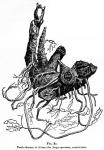 DESCRIPTION OF THE DRUG.—The rhizome of Actaea alba consists of from two to three shoots, from one-fourth to one-half an inch in diameter, which unite at the base of the stem of the plant, producing an enlargement that is often an inch in diameter. The length of each off-shoot in a large clump, from its connection with the main root, is from three to four inches. When a rhizome attains considerable age and a diameter approaching an inch, it begins to decay and is thus growing in one direction and perishing at another portion.
DESCRIPTION OF THE DRUG.—The rhizome of Actaea alba consists of from two to three shoots, from one-fourth to one-half an inch in diameter, which unite at the base of the stem of the plant, producing an enlargement that is often an inch in diameter. The length of each off-shoot in a large clump, from its connection with the main root, is from three to four inches. When a rhizome attains considerable age and a diameter approaching an inch, it begins to decay and is thus growing in one direction and perishing at another portion.
The lower portion of the stem of the plant has a pink color, and the young buds on the root and base of the stem are also pink. The taste of the fresh, young rhizome is somewhat acrid but distinctly sweet, resembling glycerrhizin, leaving a distinct sweet after-taste. The mature rhizome is of nearly a pure sweet, with but faint acridity, and the sweet impression is persistent. Upon slicing fresh, White Cohosh into alcohol, a faint pink coloration. ensues in the woody rays of the root. The roots of White Cohosh are fleshy, and about one-eighth of an inch in diameter. Dried White Cohosh is a shrunken, dark colored representation of the fresh; it is hard, horny and sweet to the taste. One hundred parts of the rhizome lose seventy-five parts by drying.
But little Actaea alba is used in medicine, although in collecting Cimicifuga the root of this plant is indiscriminately mixed with it, but this is unimportant, for undoubtedly they do not materially differ in characteristics.
CONSTITUENTS.—In 1874, Mr. William Dillmore [American Journal of Pharmacy, 1875, p. 54.] made an examination of Actaea alba, finding that the aqueous distillate possessed the odor of the root. The infusion and decoction contained the usual constituents of plants, albumen, gum, sugar, starch and extractive, but neither tannic nor gallic acid. He obtained from the alcoholic tincture two resins, one of which was soluble in ether, the other insoluble; both soluble in alkalies. After evaporating the alcoholic tincture and precipitating the resins with water, and filtration, the aqueous liquid was frothy and resembled a solution of saponin.
Our investigations with Actaea alba show it to yield a tincture of a pure, sweet taste, not acrid and not in the least bitter. It contains a resinous body exactly like the purified, resinous substance of Cimicifuga racemosa, and this was neither acrid nor bitter. Since our drug was indisputably the genuine White Cohosh, we think it possible that the bitter character of Mr. Dillmore's product was owing to a sophistication of his drug, and its acrid nature leads us also to think it likely to have contained Cimicifuga racemosa. Chemically the rhizome of Actaea alba differs mainly from that of Cimicifuga in the absence of the acrid principle that is abundant in fresh Cimicifuga, but which mostly disappears when it is dried.
MEDICAL HISTORY OF ACTAEA ALBA.—Early American medical writers distinguished White, Black, and Red Cohosh by name, but presented no authority for a physiological or therapeutical difference in character. We have it from Barton that although the Indians used Actaea in decoction, as an intended remedy in rheumatism, in connection with other herbs, they depended more upon the external application of a decoction of Actaea than its internal application. [We quote as follows: "They make a hole in the ground, into which they put a kettle, containing a quantity of the hot decoction. The rheumatic limb is laid over the kettle in such a manner as to receive the influence of the steam. They keep up the heat of the decoction by putting into it, occasionally, hot stones. I presume that the heat, independently of the vegetable employed, has something to do in the cure."—Barton's Collections, part I (1798), p. 46.]
Subsequent writers have made no addition to the medical uses of the plant, although sonic have confused the supposed poisonous properties of the berries with a probable poisonous action of the root, and others have asserted that it is cathartic. The United States Dispensatory omitted Actaea in its first edition (1833), but mentioned it in the second edition (1834), although nothing of importance has since been added. Prof. King considered White and Red Cohosh together in the first edition of the American Dispensatory, and he accepted the possibility of its being cathartic, for he wrote: "Said to be purgative and emmenagogue."
Frederick Stearns, ["The Medicinal Plants of Michigan," by Frederick Stearns. Proc. Am. Pharm. Association, 1858, p. 240.] 1858, intensified its cathartic properties, as follows: "The rhizome possesses violent purgative power." This is, no doubt, overdrawn, but that both Actaea and its near relative Cimicifuga have cathartic properties, in large doses, is supported by the investigation of Dr. Erick Sattler. [Dr. Sattler's investigations will be found in full under the next plant considered in this work, Cimicifuga racemosa.]
The facts are: Actaea alba and Actaea spicata var. rubra, together with Cimicifuga racemosa, were used by the American Indians as emmenagogues and parturients, as well as in the cure of rheumatism. Thus they became known to the whites, and by reason of their introduction were employed in domestic practice in the same manner. They accordingly were brought before the medical profession, and while the abundance of Cimicifuga, racemosa enabled it to become a common remedy, the relative scarcity of the Actaeas kept them from being as well known. There is really little difference, physically, chemically, therapeutically, or physiologically in the the three plants; they are gathered indiscriminately, and doubtless the common plant, Cimicifuga, will naturally always take the precedence. Neither species of Actaea has ever been officinal.
PHARMACEUTICAL REFERENCES TO ACTAEA.
- 1798.—Collections for a Materia Medica of the United States, Barton, p. 46.
- 1820.—The House Surgeon and Physician, p. 183.
- 1834.—Dispensatory of the United States (and subsequent editions), p. 1067.
- 1849.—Elements of Materia Medica and Therapeutics, Kost, p. 235.
- 1852.—American Dispensatory, King & Newton (and subsequent editions), p. 28.
- 1858.—Proceedings of the American Pharmaceutical Association, p. 240.
- 1875.—American Journal of Pharmacy, p. 54.
- 1881.—Specific Medication, Scudder, p, 58.
- 1884.—National Dispensatory, 3d edition (and former editions), p. 118.
Drugs and Medicines of North America, 1884-1887, was written by John Uri Lloyd and Curtis G. Lloyd.

